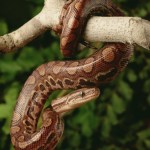Just one more example of how much humans and chimpanzees have in common. Check out this podcast describing wild chimpanzees seen drinking fermented tree sap as well as the video below.
Supplement video uploaded by the study's authors (Hockings et al., Royal Society Open Science, 2015) on Youtube.
Sources:
Scientific American
KJ Hockings, N Bryson-Morrison, S Carvalho, M Fujisawa, T Humle, WC McGrew, M Nakamura, G Ohashi, Y Yamanashi, G Yamakoshi, T Matsuzawa. Tools to tipple: ethanol ingestion by wild chimpanzees using leaf-sponges. Royal Society Open Science. DOI: 10.1098/rsos.150150 (…
tree
Image of a green tree python from www.kids.britannica.com J.H. Pete Carmichael—The Image Bank/Getty Images
Dr. Greg Byrnes (Siena College, Loudonville, NY) and Dr. Bruce Jayne (University of Cincinnati, OH) discovered that snakes use more force than is necessary to support their weight when climbing. To climb, snakes rely on friction and repeatedly contract and extend their bodies, a process called concertina locomotion. To study the forces generated by snakes during this type of locomotion, the researchers constructed a vertical cylinder that was covered with textured tennis racket…
Infrared image of a koala (from S. Griffiths)
New research sheds light why koalas (Phascolarctos cinereus) spend so much time hugging trees. As shown in the infrared image above, the trees stay cool on hot days. Since koalas do not sweat, hugging trees is another method to keep their cool in addition to panting and licking their fur. The research also shows that the animals who hug trees lose less water through evaporation that those that do not hug trees.
I think I might need to start hugging trees this summer.
Source:
Briscoe NJ, Handasyde KA, Griffiths SR, Porter WP,…
A twisted tree situated along a trail at Bryce Canyon National Park, Utah.
Mammal hairs preserved in amber specimen ARC2-A1-3. a - First fragment; b - Line drawing of first fragment; c - Second fragment; d - Line drawing of second fragment; e - Close-up of second fragment to show the cuticular surface.
About 100 million years ago, in a coastal forest located in what is today southwestern France, a small mammal skittered up the trunk of a conifer tree. As it did so it lost a few of its hairs, and this minor event would have been entirely unremarkable if two of those hairs had not settled in some tree sap and, in the course of time, become entombed in a piece of…
In California's Jurupa Mountains, there is a very unusual group of tree - a Palmer's oak. Unlike the mighty trees that usually bear the oak name, this one looks like little more than a collection of small bushes. But appearances can be deceiving. This apparently disparate group of plants are all clones of a single individual, and a very old one at that.
By repeatedly cloning itself, the Palmer's oak has lived past the separation of Britain from continental Europe, the demise of the mammoths and saber-toothed cats, and the birth of human agriculture. It is among the oldest plants in…
Autumn is a time of incredible beauty, when the world becomes painted in the red, orange and yelllow palette of falling leaves. But there may be a deeper purpose to these colours, and the red ones in particular. In the eyes of some scientists, they aren't just decay made pretty - they are a tree's way of communicating with aphids and other insects that would make a meal of it. The message is simple: "I am strong. Don't try it."
During winter, trees withdraw the green chlorophyll from their leaves, and textbooks typically say that autumn colours are produced by the pigments that are left…
tags: tree of fire, UWS, Upper West Side, Manhattan, NYC, image of the day
Tree of Fire.
West 83rd between Columbus and Amsterdam Avenues, Manhattan, NYC.
Image: GrrlScientist, 6 November 2008 [larger view].
Even creationists have said that if you find something that's alive now that's over 6000 years old, it would prove to them that the Earth is at least that old.
Previously, the oldest tree in the world was thought to be a Bristlecone Pine in California, known as the Methuselah tree, at 4,840 years old (as of 2008).
It's huge! But you can also date a tree not by its trunk, but by its root structure. And as The Log Blog reports, Swedish researchers have found a tree on Fulu Mountain that is over 9,000 years old! Although it looks puny because its trunk dies every few hundred years or so and it…
tags: tree, Konza Prairie, Manhattan, Kansas, nature, Image of the Day
Trunk from what is probably a Black Locust, Robinia pseudoacacia,
colonized by a community of crustose lichens [study]
on the Konza Prairie, near Manhattan Kansas. March 2008.
Image: GrrlScientist 2008. [larger view].
Climbing Insect Robot
Official roboty info:
RiSE is a small six-legged robot that climbs vertical terrain such as walls, trees and fences. RiSE's feet have claws, micro-claws or sticky material, depending on the climbing surface. RiSE changes posture to conform to the curvature of the climbing surface and a fixed tail helps RiSE balance on steep ascents. RiSE is about 0.25 m long, weighs 2 kg, and travels 0.3 m/s.
(more below the fold)
Each of RiSE's six legs is powered by two electric motors. An onboard computer controls leg motion, manages communications, and services a variety of sensors…
I was planning on putting up one of my patented mega-posts this evening, but unfortunately I just don't have it in me at the moment. It's based on a presentation I made today involving scavenging and early hominids, and while I'm sure some of you will be able to make the right connections (especially if you're familiar with the work of a certain Rutgers alum) here's a video of a certain behavior exhibited by one of my most favorite big cats, the Leopard (Panthera pardus), that'll prominently figure in tomorrow's discussion;


